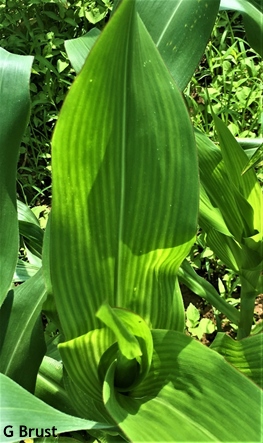For the last couple of years, I have talked about and conducted research on sulfur (S) deficiencies in watermelon. At several meetings I was asked if the deficiency also appears in (field) corn. I could only relate the comments I have heard from several corn growers that they have often found their corn crop to be low or deficient in sulfur. I bring all this up again because I have seen several sweet corn fields lately that have sulfur deficiencies (see photo).


One of the possible reasons we are seeing more S deficiency is because less sulfur is being deposited into the soil from the atmosphere due to reductions in acid rain. In 1986, about 24 lbs/a of sulfate were deposited in Maryland soils per year, however in 2011 it was closer to just 8 lbs/a each year. Organic matter supplies most of the sulfur to the crop, but sulfur must be mineralized to sulfate-S to be taken up by crop plants.
Because mineralization is carried out by soil microorganisms, soil temperature and moisture primarily determine when and how much sulfur is made available to the crop. Excessively wet (like we have had most of this summer) or dry conditions reduce microbial activity and reduce S availability from soil organic matter. Sulfate is relatively mobile in most soils and easily can be leachedfrom soils, especially sandy soils. Soils low in organic matter are much more likely to be deficient in S.
In the field sulfur deficiency can be highly variable since soil sulfur availability varies considerably with soil organic matter and texture. Sulfur deficiency is often seen in sandier, lower organic matter, hillier areas of a field while low lying, greater organic matter areas usually have sufficient levels of S. Sulfur can be added to the crop in combination with several other nutrients such as ammonium or potassium and spray-grade ammonium sulfate is a good choice for foliar applications.
There are other deficiencies (and problems such as root diseases) that can cause striping (although the one pictured here was S) and only by conducting a tissue test can you be sure. Magnesium deficiency may cause striping and/or reddening of corn leaves. The yellow areas between the veins often appear as ‘beaded’ lines rather than solid stripes. Zinc deficiency may cause striping that begins at the base of the leaf and progresses to the tip. These stripes often coalesce to form a white band along the edge of the leaf or the midrib. Manganese deficiency causes striping that is olive green or dark yellow in color with veins remaining green. High pH, high organic matter, and dry soil conditions can cause Mn deficiency.
– Jerry Brust, IPM Vegetable Specialist, University of Maryland; [email protected]














